Overclocking Buyer's Guide - September 2004
by Wesley Fink on September 17, 2004 12:05 AM EST- Posted in
- Guides
Computer Case
Recommendation: Coolermaster CM Stacker (STC-T01)Price: $174 shipped
Overclockers tend to swap components at a dizzying rate, always looking for something that will run just a little faster or perform a little higher on a competitive benchmark. Since components are likely to be swapped a lot, a case should be as flexible as possible, providing for future components as well as those that you might use today. Cooling is also a huge concern for overclockers, so a case that provides exceptional cooling is also a plus.
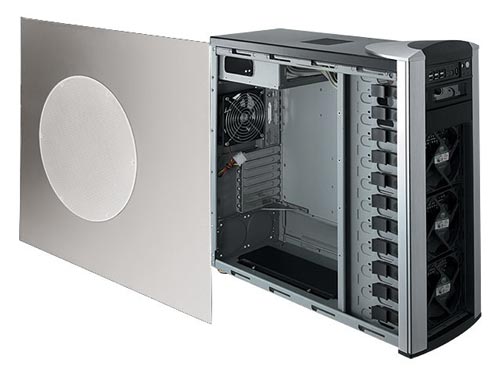
The aluminum-panel/steel frame Coolermaster CM Stacker is a case that fits the bill for the overclocker. Not only does it support 11 5-1/4" devices, it also supports both standard ATX and coming BTX designs. The case comes with conversion instructions for mounting a BTX motherboard. You also get support for either one or two standard ATX power supplies, and up to 8 internal fans, in addition to a unique optional crossflow fan.
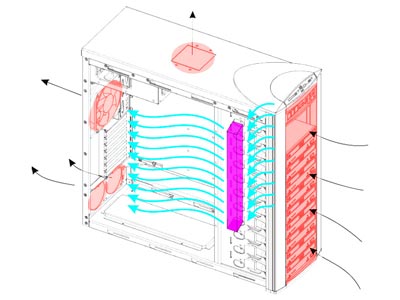
Coolermaster cases are still some of the best for build-quality that you will find anywhere, and the CM Stacker is the most flexible case design that we have even seen. Whatever your particular desires in overclocking your system, you are likely to find a way to do what you need to to do with the CM Stacker.
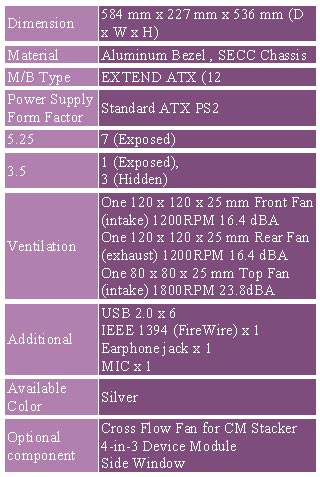
You have to see the flexibility of the CM Stacker to believe it.
Power Supply
Recommendation: OCZ Power Stream 520WPrice: $130 shipped
The first thing most overclockers learn is that the power supply does matter because the first wall most overclockers run into is the inadequate power supply that came with their white-box computer. Overclocking demands much more of a computer system than running the system at stock speeds. If you think a Prescott at 3.4Ghz demands wattage, then you realize quickly that a Prescott at 4.0Ghz demands even more power. The same is true of video cards. If a 6800 Ultra Extreme demands a decent 470W power supply, then you will need even more power when you overclock that 6800 Ultra to higher GPU and memory speeds.
You also learn quickly that all power supplies are not created equal. Most power supply ratings are combined ratings, as regular readers have learned in Power Supply reviews at AnandTech. This means that as some of the power supply rails are driven, other rails drop in power, and may end up supplying less than ideal power under stress. The very best power supplies individually control the power rails. They, therefore, usually handle the stress of overclocking much better than a PS with a combined rating. These are the power supplies that are most coveted by overclockers.
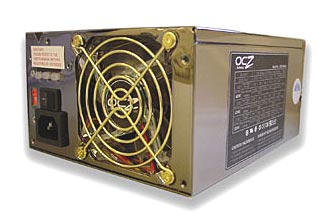
A superb example of a power supply geared to overclockers is the new OCZ Power Stream 520. It was designed from the ground up for overclockers, and features individual rails that are even tweakable for higher output or exact values. There are even LEDs on the rear of the black chrome case that tell you if the PS is operating in spec, under spec, or over spec. These same LEDs can even be used to tweak individual rails for optimum power.
520W sounds like a lot of power and it is, but truthfully, this power supply would probably be rated at 700 watts by a manufacturer who was trying to impress with specs. The 520W rating is conservative and this PS can easily handle almost anything an overclocker wants to throw at it. While the OCZ Power Stream are new to the market, they have quickly become favorites of the extreme overclocking community.
You will also find a stock 24-pin ATX power connector that will work with the new Socket 775 motherboards and servers, as well as a 24-pin to 20-pin adapter to use with motherboards requiring a standard 20-pin connector. There are also extra long SATA and 4-pin Molex connectors to power anything you might put in a full tower case or the CM stacker, as well as special heavy duty cables for the demands of hard drives and the latest high-end video cards. You can find out more about the Power Stream power supplies at the Power Stream product page.
Alternative: Antec True Power 480W
Price: $89 shipped
If $130 for a top power supply seems a bit rich for your budget, there is a very good alternative with the Antec True Power 480. The True Power series feature individually powered rails, unlike the lesser Antec power supplies, which brings excellent stability to power-hungry overclocking.
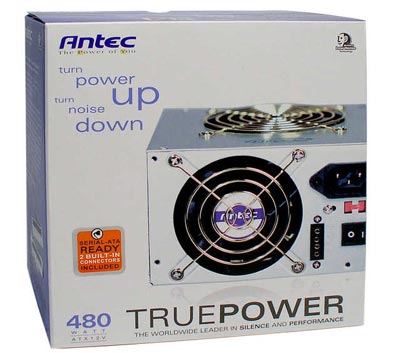
The True Power series, in particular, is one of the most trusted power supplies among enthusiasts, and it will provide your overclocked system with stable power and some reserve for more overclocking. While a good quality 350W or 400W power supply might do the job for processors and video cards at stock speeds, you will definitely need a high-quality power supply like the True Power 480 if you plan to overclock.
If you cannot find the lowest prices on the products that we've recommended on this page, it's because we don't list some of them in our RealTime pricing engine. Until we do, we suggest that you do an independent search online at the various vendors' web sites. Just pick and choose where you want to buy your products by looking for a vendor located under the "Vendor" heading.










31 Comments
View All Comments
whitelight - Friday, September 17, 2004 - link
For ram, look into PQI's 2-2-2-5 (2x512mb) solution. It overclocks really well with relatively tight timings and has samsung's tccd chips. It's also cheaper than other solutions ($250)axel - Friday, September 17, 2004 - link
Hi, very interesting article indeed.The only thing I do not really understand, and rather see as an error is the following:
You say that almost every top overclockers i.e. in the futuremark 3dmarks ORB database are on AMD platforms. Though, except if I'm not looking at the right place, if I'm taking into account the 5 best scores, I see that 4 of them are running Pentium4 platforms, and only one is an AMD (which is actually on the 4th position of the top-5).
AlphaFox - Friday, September 17, 2004 - link
Id like to see how the XP stacks up against the 64 when overclocked.. I have a XP mobile 2600 and am running it at 2.46Ghz and everything I throw at it runs as smooth as silk.. I dont see a need to upgrade unless there was something I couldnt run, or run smooth.eetnoyer - Friday, September 17, 2004 - link
Any chance you've tested the limits of the ballistix RAM on the DFI. If so, how high did it reach?Nickel020 - Friday, September 17, 2004 - link
Nice article, but there is a mistake on page 5 (CPU and Motherboard: VALUE OC Recommendations):The heatsinks listed (XP-90 & 120) are made by Thermalright, not Thermaltake.
Shinei - Friday, September 17, 2004 - link
Nice article, though I'm curious to see how the 3200-M64 performs compared to the Clawhammer and Newcastle desktop cores. I know the Newcastle revisions have an upgraded memory controller, or something like that; does the 3200-M64 have the same upgrades, or is it based on the older Clawhammer revision?And why the choice of OCZ's PowerStream? Antec puts out a 550w that's just as reliable as the 480w you suggested as an alternative... Unless I missed a review that pointed out the OCZ to be more robust than the Antec supply.
qquizz - Friday, September 17, 2004 - link
This is my type of review. I can't have too many of them. I do agree with slashbinslashbash about some guidance on value oriented RAM. The price differences between 2-2-2-5 memory and say 2.5-x-x-x value memory is rather drastic. But if none of it will o/c then so be it.slashbinslashbash - Friday, September 17, 2004 - link
#2: Under the Value OC Alternative system Wesley writes "Buy an ATI 9800 PRO for $200 less and overclock the heck out of it." So it looks like you were right on the money ;) Personally I'm looking at a 9600XT All-In-Wonder as it's about the same price at Newegg; less performance in games (still reasonable framerates in Doom3) but with the ever-so-cool All-In-Wonder functionality added.slashbinslashbash - Friday, September 17, 2004 - link
Great guide. The only thing that I'd ask you to do differently (or rather, to add next time) is to make a "value" recommendation for the RAM. Nowadays I won't use any less than a gig of RAM, but I think it's silly to pay substantially more for RAM than for the CPU. Even just one stick of 512MB in the Value Alternative system costs more than the CPU.I'd like to know some "value" RAM alternatives that might not have such aggressive latency timings but will still keep up with the mobo and CPU, if it's possible. I know you guys can't test every cheapo stick of RAM out there, but... any sort of guidance would be appreciated. All the big brands offer "Value" RAM. Will none of it overclock? Is the performance from the recommended $280 (for 1GB) RAM actually worth the $120 premium it commands over, say, two $80 sticks of Corsair Value Select (on front page of ZipZoomFly)? Would that $120 be better spent on the CPU? It's more than the difference between the Sempron 3100+ and the "Value Recommended" system's A64 3200+.. and it nearly covers the upgrade to both the CPU and motherboard.
Also, two errors: 1) the eVGA 6800GT is listed as $389 under the Value Alternative system but at $383 under the Value Recommended system; 2) the Value Recommended system sums to $1440, not $1460.
Again, great guide, it's probably what I'll be looking at when I decide on my next system.
decptt - Friday, September 17, 2004 - link
For AGP VGA, do you have a value altervative for limited budget not playing doom3?For me, 6800 is too powerful to run multimedia and encoding DivX.
Do you think 9800Pro can be runner up?
Anyone knows about when ATI X series for AGP (X300, X600) will be coming? or ONLY PCI Express :'(